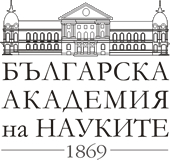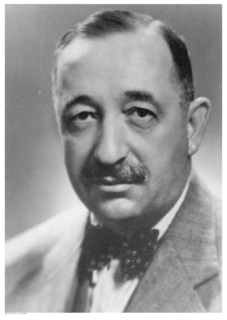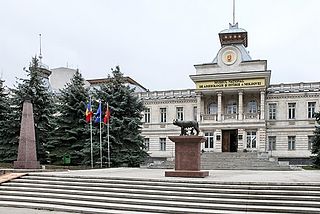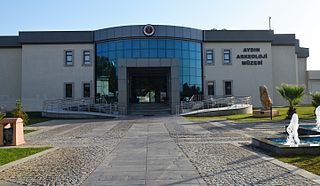Coordinates: 42°41′46.79″N23°19′28.43″E / 42.6963306°N 23.3245639°E

A geographic coordinate system is a coordinate system that enables every location on Earth to be specified by a set of numbers, letters or symbols. The coordinates are often chosen such that one of the numbers represents a vertical position and two or three of the numbers represent a horizontal position; alternatively, a geographic position may be expressed in a combined three-dimensional Cartesian vector. A common choice of coordinates is latitude, longitude and elevation. To specify a location on a plane requires a map projection.
Contents
Interior of the first floor | |
| Established | 1892 |
|---|---|
| Location | Sofia, Bulgaria |
| Type | Archaeological museum and research institute |
| Director | Lyudmil Vagalinski |
The National Archaeological Museum (Bulgarian : Национален археологически музей, Natsionalen arheologicheski muzey) is an archaeological museum in the centre of Sofia, the capital of Bulgaria. It occupies the building of the largest and oldest former Ottoman mosque in the city, originally known as Koca Mahmut Paşa Camii. The construction started in 1451 under grand vizier Veli Mahmud Pasha but due to his death in 1474 the mosque has been completed in 1494. The museum was established as a separate entity in 1893 as the National Museum directed by Czech Václav Dobruský with its headquarters in the former mosque that previously housed the National Library between 1880 and 1893.

Bulgarian, is an Indo-European language and a member of the Southern branch of the Slavic language family.
Archaeology, or archeology, is the study of human activity through the recovery and analysis of material culture. The archaeological record consists of artifacts, architecture, biofacts or ecofacts and cultural landscapes. Archaeology can be considered both a social science and a branch of the humanities. In North America archaeology is a sub-field of anthropology, while in Europe it is often viewed as either a discipline in its own right or a sub-field of other disciplines.

A museum is an institution that cares for (conserves) a collection of artifacts and other objects of artistic, cultural, historical, or scientific importance. Many public museums make these items available for public viewing through exhibits that may be permanent or temporary. The largest museums are located in major cities throughout the world, while thousands of local museums exist in smaller cities, towns and rural areas. Museums have varying aims, ranging from serving researchers and specialists to serving the general public. The goal of serving researchers is increasingly shifting to serving the general public.
The museum was officially opened and inaugurated in 1905, as by then all archaeological exhibits previously kept all over the city were moved there, in the presence of Knyaz Ferdinand of Bulgaria and Minister of Enlightenment Ivan Shishmanov.
Several additional halls and administrative buildings of the museum were constructed in the following years, which continues to use the historic stone building of the old mosque despite the often unfavourable conditions, notably the humidity in the summer. The museum has five exhibition halls: Central Hall, Prehistory, Middle Ages, Treasure, and a special temporary exhibition. It is managed by the Bulgarian Academy of Sciences.

The Bulgarian Academy of Sciences is the National Academy of Bulgaria, established in 1869. The Academy, located in Sofia, is autonomous and has a Society of Academicians, Correspondent Members and Foreign Members. It publishes and circulates different scientific works, encyclopedias, dictionaries and journals, and runs its own publishing house.





















